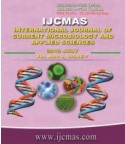


 National Academy of Agricultural Sciences (NAAS)
National Academy of Agricultural Sciences (NAAS)

|
PRINT ISSN : 2319-7692
Online ISSN : 2319-7706 Issues : 12 per year Publisher : Excellent Publishers Email : editorijcmas@gmail.com / submit@ijcmas.com Editor-in-chief: Dr.M.Prakash Index Copernicus ICV 2018: 95.39 NAAS RATING 2020: 5.38 |
The present investigation was carried out in Renewable Energy Laboratory of the Department of Renewable and Bio Energy Engineering, College of Agriculture Engineering & Technology, CCS Haryana Agriculture University, Hisar. Biogas production was recorded for 70 days (ten weeks) in batch type digestion. Anaerobic digestion of fresh cattle dung (CD) and paddy straw (PS) in different ratio was carried out under batch system. Paddy straw was mixed with cattle dung in different percentage 5%, 7%, 15%, 22.5% and one control. Methane content in all the reactors varied between 60-62%. Paddy straw had more cellulose (31.0) and hemicelluloses (21.1) but lesser lignin (6.0) as compared to cattle dung. Paddy straw was chopped 2-3 cm pieces and soaked in water overnight. Soaked paddy straw was mixed with cattle dung for preparation of different ratio. The temperature ranged from 14 to 36oC during ten weeks. The results indicated that biogas production was in the range of 0.63 to 5.84 l/week in digester-A and 0.73-5.87, 0.98-5.40, 1.10-4.98, 0.57-5.85 l/week in digester B, C, D and E. After a batch study, around 27.51-litres of biogas production was observed in reactor containing 5% paddy straw with cattle dung as compared to other reactor. As digestion period increases, the biogas production was also increased because paddy straw contain more lignin, cellulose and silica therefore it takes more time for digestion. A lot of variation in daily biogas production was also recorded due to fluctuating environmental conditions.
 |
 |
 |
 |
 |